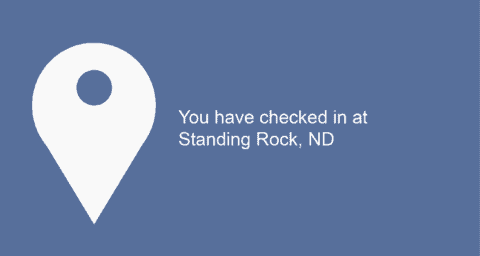Internet content and social media can have a huge influence on grassroots movements — just ask your bounty of Facebook friends who have “checked in” at Standing Rock in the past month.
It would seem, in this digital age, that participation in anything is as simple as clicking a button. Millennials must be the most involved generation, just look at our Google Calendars. Each day is a new opportunity to digitally confirm your presence at events around the world.
It has become a trend, maybe even a meme, to show support and take action, via Facebook’s check-in feature, for the efforts in Standing Rock, North Dakota, where protesters have gathered en masse to prevent the rerouting of the Dakota Access Pipeline through Indigenous lands.
The theory of this action is such: by checking in at Standing Rock, even from the comfort of your own home, you are using your voice to confuse and hinder the  efforts of police and government officials who might use social media as a means of intercepting protestors and organizers who are actually on site.
efforts of police and government officials who might use social media as a means of intercepting protestors and organizers who are actually on site.
This doesn’t seem like a bad thing, right? Of course not, but it has been met with more online criticism than the Cincinnati Zoo after the death of a certain silverback gorilla. Should we be wary of this seemingly “slacktivist” effort, or should we be glad for at least the inkling of solidarity that is filling our newsfeeds?
Many have questioned the legitimacy of Facebook check-ins as concrete action after the Morton County Sheriff’s Department released a statement denying their use of social media to learn information about the protests, despite the growing ease for law enforcement to do just that. Facebook can provide a plethora of information to law enforcement beyond that accessible by regular users.
Other criticisms have come in the form of concerned individuals saying that a Facebook post just isn’t enough. There is, undeniably, a need for a physical presence on the ground.
Protests aren’t effective when they’re easy and there are people who are putting their lives at risk to ensure that this potentially damaging endeavor, which is posing a very real threat to the health of Indigenous communities, does not go forward.
I will not pretend to be an expert on algorithms, and I recognize that my voice — when speaking of the events in Standing Rock — shouldn’t be heard over that of an Indigenous individual. I am comfortably living, studying and writing Sheaf articles without the immediate fear that I or anyone I am close to is going to be directly impacted by this pipeline.
It does not bode well to discourage people from using what voice they may have to join these efforts. Any support is good support, even if it only goes as far as a few Facebook posts.
At the very least, this check-in trend has sparked a conversation among individuals who may not have sought out this information on their own, and who may have felt that any action they could take to help the movement was beyond their means.
I implore you, however, to consider what really is within your means. Whether you have already or are planning to make a post or share a video, picture or article, ask yourself if there is more you can do and respond honestly. There are actions to take right here in our community.
For example, on Nov. 3, 2016, University of Saskatchewan students participated in a round dance flash mob at Midtown Plaza and the U of S hosted a teach-in on Nov. 15 which brought students together with members of Indigenous communities to learn about the issue and discuss potential for change. There is potential for many more events like these in the future. If you can lend your voice, do.
—
Emily Migchels
Graphic: Lesia Karalash / Graphics Editor